Global Business: Foreign Direct Investment in the Asian Century Report
VerifiedAdded on 2023/01/17
|7
|1092
|62
Report
AI Summary
This report provides a comprehensive analysis of Foreign Direct Investment (FDI), examining its costs and benefits for both home and host countries. It delves into how FDI impacts capital and employment, the balance of payments, and the transfer of resources. The report also explores the various policy instruments governments use to influence FDI, including incentives like tax concessions and restrictions such as capital outflow limits. Furthermore, it identifies the implications for managers, emphasizing the importance of creating valuable jobs, improving the skill base of the host country, and enhancing the competitiveness of domestic companies. Examples such as the Renault-Nissan Alliance, Mexican Maquiladores, the US-Malaysia FDI relationship, and McDonald's are used to illustrate the concepts discussed. The report also references government policies, such as India's FDI policy revisions and the 'Make in India' initiative, highlighting the dynamic nature of FDI regulations.
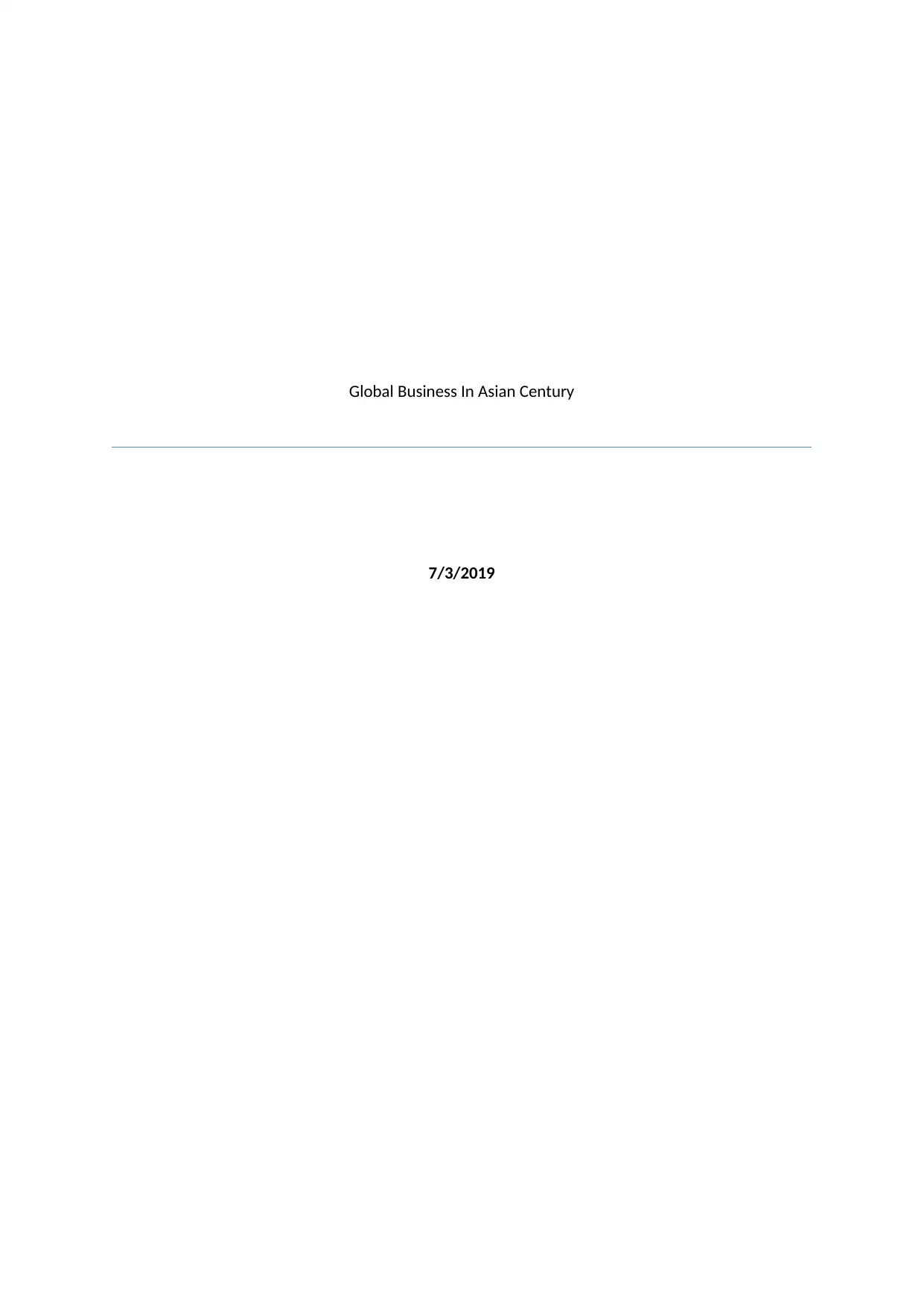
Global Business In Asian Century
7/3/2019
7/3/2019
Paraphrase This Document
Need a fresh take? Get an instant paraphrase of this document with our AI Paraphraser
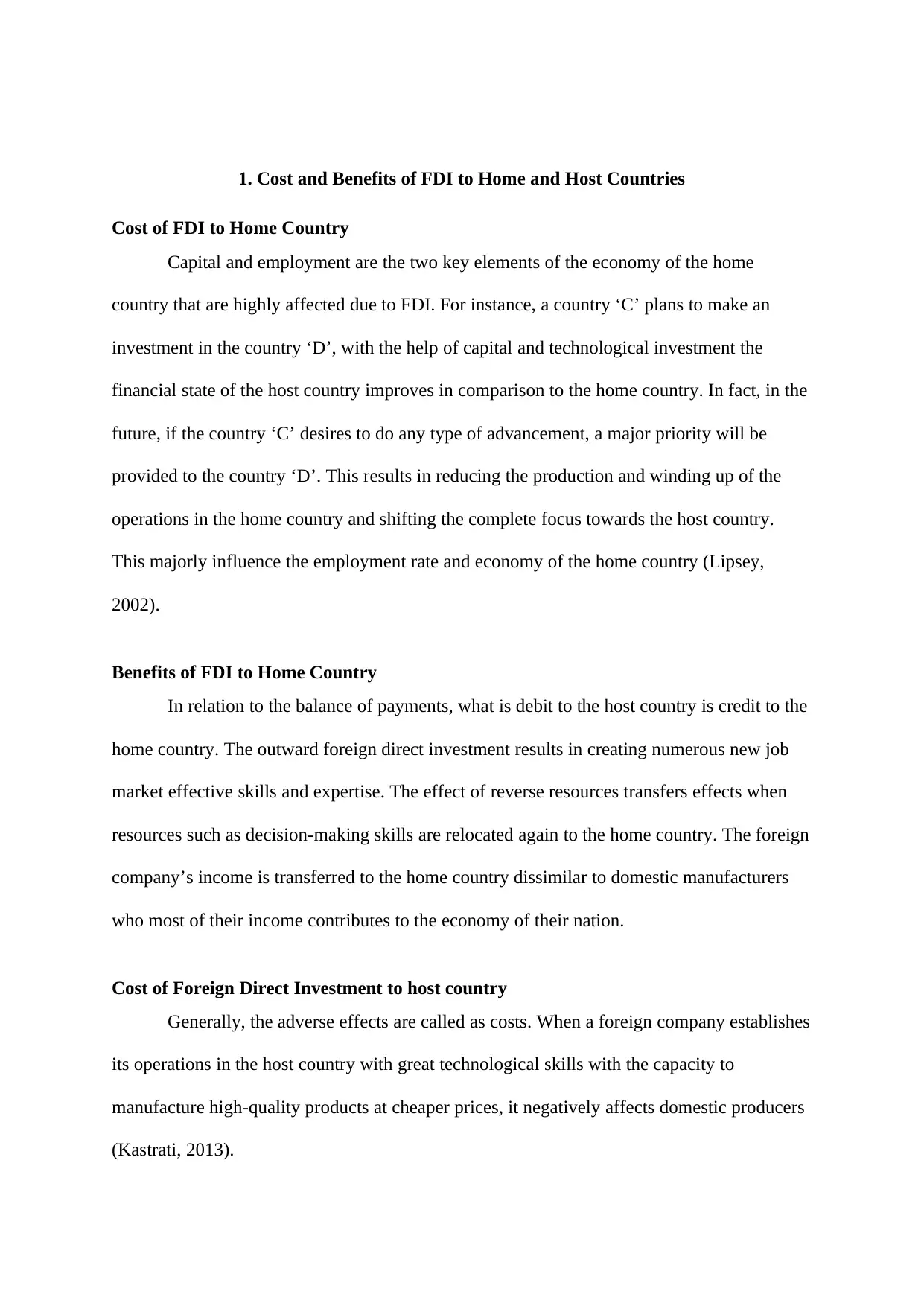
1. Cost and Benefits of FDI to Home and Host Countries
Cost of FDI to Home Country
Capital and employment are the two key elements of the economy of the home
country that are highly affected due to FDI. For instance, a country ‘C’ plans to make an
investment in the country ‘D’, with the help of capital and technological investment the
financial state of the host country improves in comparison to the home country. In fact, in the
future, if the country ‘C’ desires to do any type of advancement, a major priority will be
provided to the country ‘D’. This results in reducing the production and winding up of the
operations in the home country and shifting the complete focus towards the host country.
This majorly influence the employment rate and economy of the home country (Lipsey,
2002).
Benefits of FDI to Home Country
In relation to the balance of payments, what is debit to the host country is credit to the
home country. The outward foreign direct investment results in creating numerous new job
market effective skills and expertise. The effect of reverse resources transfers effects when
resources such as decision-making skills are relocated again to the home country. The foreign
company’s income is transferred to the home country dissimilar to domestic manufacturers
who most of their income contributes to the economy of their nation.
Cost of Foreign Direct Investment to host country
Generally, the adverse effects are called as costs. When a foreign company establishes
its operations in the host country with great technological skills with the capacity to
manufacture high-quality products at cheaper prices, it negatively affects domestic producers
(Kastrati, 2013).
Cost of FDI to Home Country
Capital and employment are the two key elements of the economy of the home
country that are highly affected due to FDI. For instance, a country ‘C’ plans to make an
investment in the country ‘D’, with the help of capital and technological investment the
financial state of the host country improves in comparison to the home country. In fact, in the
future, if the country ‘C’ desires to do any type of advancement, a major priority will be
provided to the country ‘D’. This results in reducing the production and winding up of the
operations in the home country and shifting the complete focus towards the host country.
This majorly influence the employment rate and economy of the home country (Lipsey,
2002).
Benefits of FDI to Home Country
In relation to the balance of payments, what is debit to the host country is credit to the
home country. The outward foreign direct investment results in creating numerous new job
market effective skills and expertise. The effect of reverse resources transfers effects when
resources such as decision-making skills are relocated again to the home country. The foreign
company’s income is transferred to the home country dissimilar to domestic manufacturers
who most of their income contributes to the economy of their nation.
Cost of Foreign Direct Investment to host country
Generally, the adverse effects are called as costs. When a foreign company establishes
its operations in the host country with great technological skills with the capacity to
manufacture high-quality products at cheaper prices, it negatively affects domestic producers
(Kastrati, 2013).
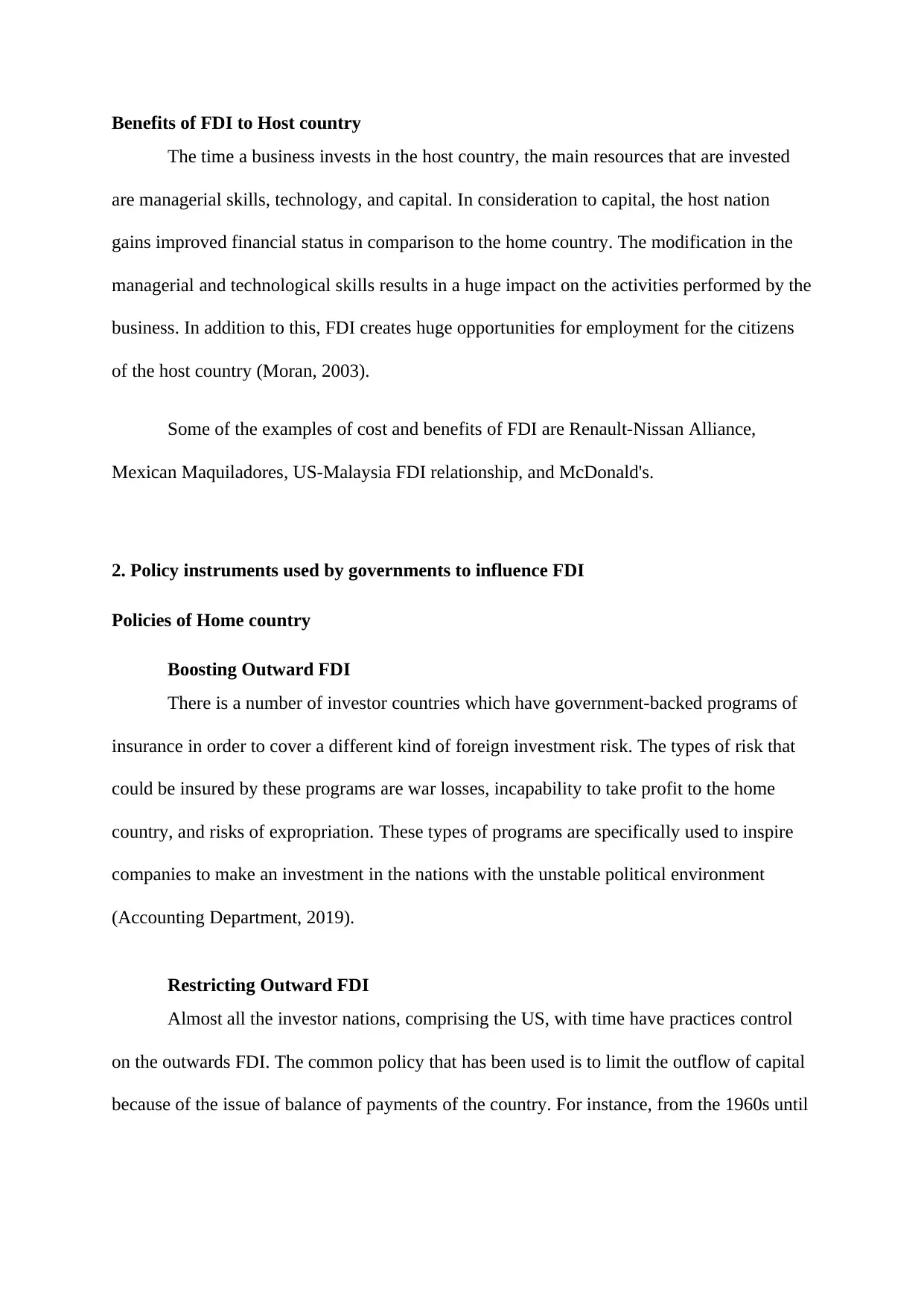
Benefits of FDI to Host country
The time a business invests in the host country, the main resources that are invested
are managerial skills, technology, and capital. In consideration to capital, the host nation
gains improved financial status in comparison to the home country. The modification in the
managerial and technological skills results in a huge impact on the activities performed by the
business. In addition to this, FDI creates huge opportunities for employment for the citizens
of the host country (Moran, 2003).
Some of the examples of cost and benefits of FDI are Renault-Nissan Alliance,
Mexican Maquiladores, US-Malaysia FDI relationship, and McDonald's.
2. Policy instruments used by governments to influence FDI
Policies of Home country
Boosting Outward FDI
There is a number of investor countries which have government-backed programs of
insurance in order to cover a different kind of foreign investment risk. The types of risk that
could be insured by these programs are war losses, incapability to take profit to the home
country, and risks of expropriation. These types of programs are specifically used to inspire
companies to make an investment in the nations with the unstable political environment
(Accounting Department, 2019).
Restricting Outward FDI
Almost all the investor nations, comprising the US, with time have practices control
on the outwards FDI. The common policy that has been used is to limit the outflow of capital
because of the issue of balance of payments of the country. For instance, from the 1960s until
The time a business invests in the host country, the main resources that are invested
are managerial skills, technology, and capital. In consideration to capital, the host nation
gains improved financial status in comparison to the home country. The modification in the
managerial and technological skills results in a huge impact on the activities performed by the
business. In addition to this, FDI creates huge opportunities for employment for the citizens
of the host country (Moran, 2003).
Some of the examples of cost and benefits of FDI are Renault-Nissan Alliance,
Mexican Maquiladores, US-Malaysia FDI relationship, and McDonald's.
2. Policy instruments used by governments to influence FDI
Policies of Home country
Boosting Outward FDI
There is a number of investor countries which have government-backed programs of
insurance in order to cover a different kind of foreign investment risk. The types of risk that
could be insured by these programs are war losses, incapability to take profit to the home
country, and risks of expropriation. These types of programs are specifically used to inspire
companies to make an investment in the nations with the unstable political environment
(Accounting Department, 2019).
Restricting Outward FDI
Almost all the investor nations, comprising the US, with time have practices control
on the outwards FDI. The common policy that has been used is to limit the outflow of capital
because of the issue of balance of payments of the country. For instance, from the 1960s until
⊘ This is a preview!⊘
Do you want full access?
Subscribe today to unlock all pages.

Trusted by 1+ million students worldwide
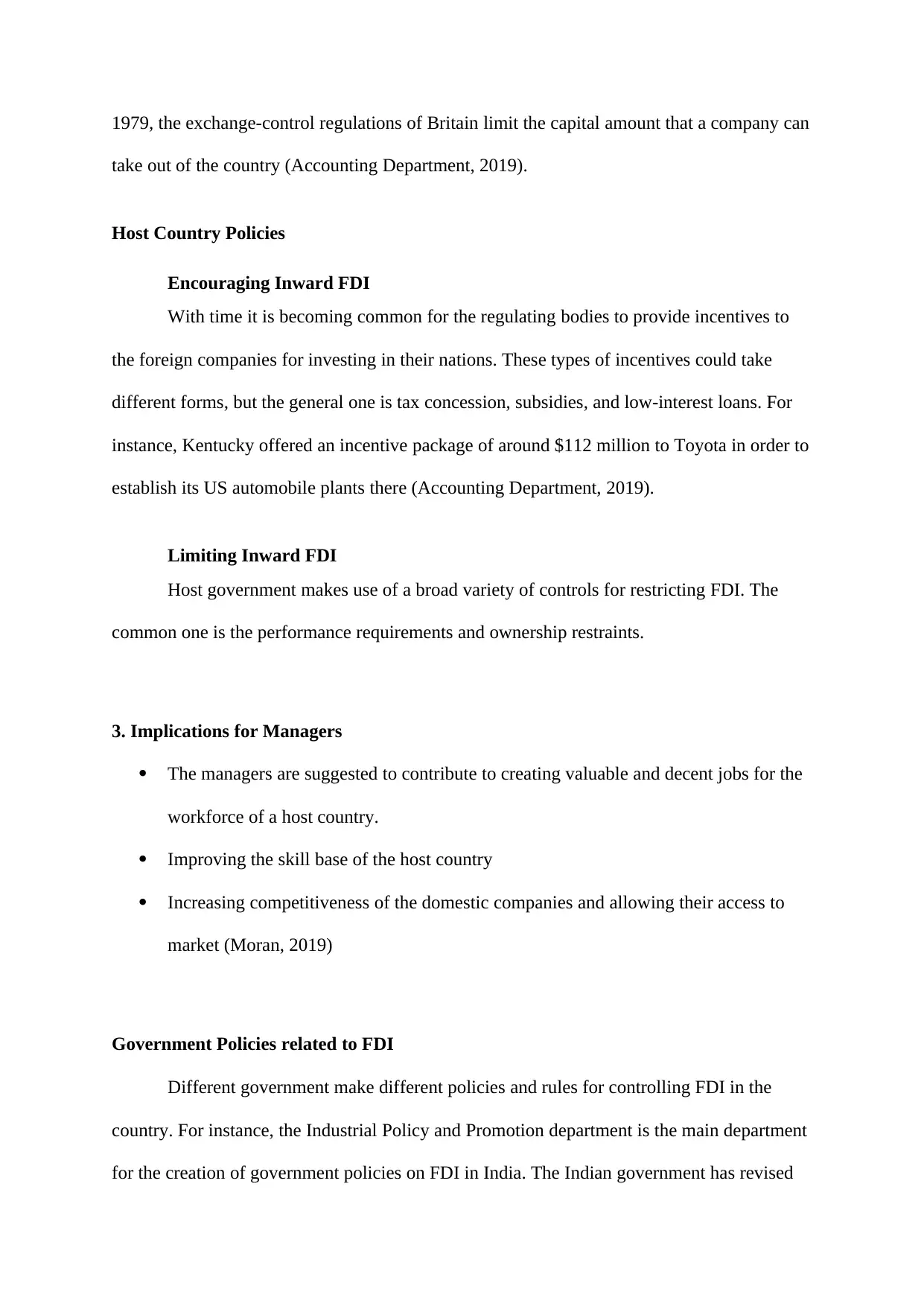
1979, the exchange-control regulations of Britain limit the capital amount that a company can
take out of the country (Accounting Department, 2019).
Host Country Policies
Encouraging Inward FDI
With time it is becoming common for the regulating bodies to provide incentives to
the foreign companies for investing in their nations. These types of incentives could take
different forms, but the general one is tax concession, subsidies, and low-interest loans. For
instance, Kentucky offered an incentive package of around $112 million to Toyota in order to
establish its US automobile plants there (Accounting Department, 2019).
Limiting Inward FDI
Host government makes use of a broad variety of controls for restricting FDI. The
common one is the performance requirements and ownership restraints.
3. Implications for Managers
The managers are suggested to contribute to creating valuable and decent jobs for the
workforce of a host country.
Improving the skill base of the host country
Increasing competitiveness of the domestic companies and allowing their access to
market (Moran, 2019)
Government Policies related to FDI
Different government make different policies and rules for controlling FDI in the
country. For instance, the Industrial Policy and Promotion department is the main department
for the creation of government policies on FDI in India. The Indian government has revised
take out of the country (Accounting Department, 2019).
Host Country Policies
Encouraging Inward FDI
With time it is becoming common for the regulating bodies to provide incentives to
the foreign companies for investing in their nations. These types of incentives could take
different forms, but the general one is tax concession, subsidies, and low-interest loans. For
instance, Kentucky offered an incentive package of around $112 million to Toyota in order to
establish its US automobile plants there (Accounting Department, 2019).
Limiting Inward FDI
Host government makes use of a broad variety of controls for restricting FDI. The
common one is the performance requirements and ownership restraints.
3. Implications for Managers
The managers are suggested to contribute to creating valuable and decent jobs for the
workforce of a host country.
Improving the skill base of the host country
Increasing competitiveness of the domestic companies and allowing their access to
market (Moran, 2019)
Government Policies related to FDI
Different government make different policies and rules for controlling FDI in the
country. For instance, the Industrial Policy and Promotion department is the main department
for the creation of government policies on FDI in India. The Indian government has revised
Paraphrase This Document
Need a fresh take? Get an instant paraphrase of this document with our AI Paraphraser

its policy of FDI in order to increase the flow of FDI. In the year 2014, the government raised
the upper limit of foreign investment from 26% to 49% in the sector of insurance (Economic
Times, 2016). In the same year, the government introduced the initiative of ‘Make in India’ in
which the policy of FDI for around 25 sectors was further liberalized (Make in India, 2019).
the upper limit of foreign investment from 26% to 49% in the sector of insurance (Economic
Times, 2016). In the same year, the government introduced the initiative of ‘Make in India’ in
which the policy of FDI for around 25 sectors was further liberalized (Make in India, 2019).
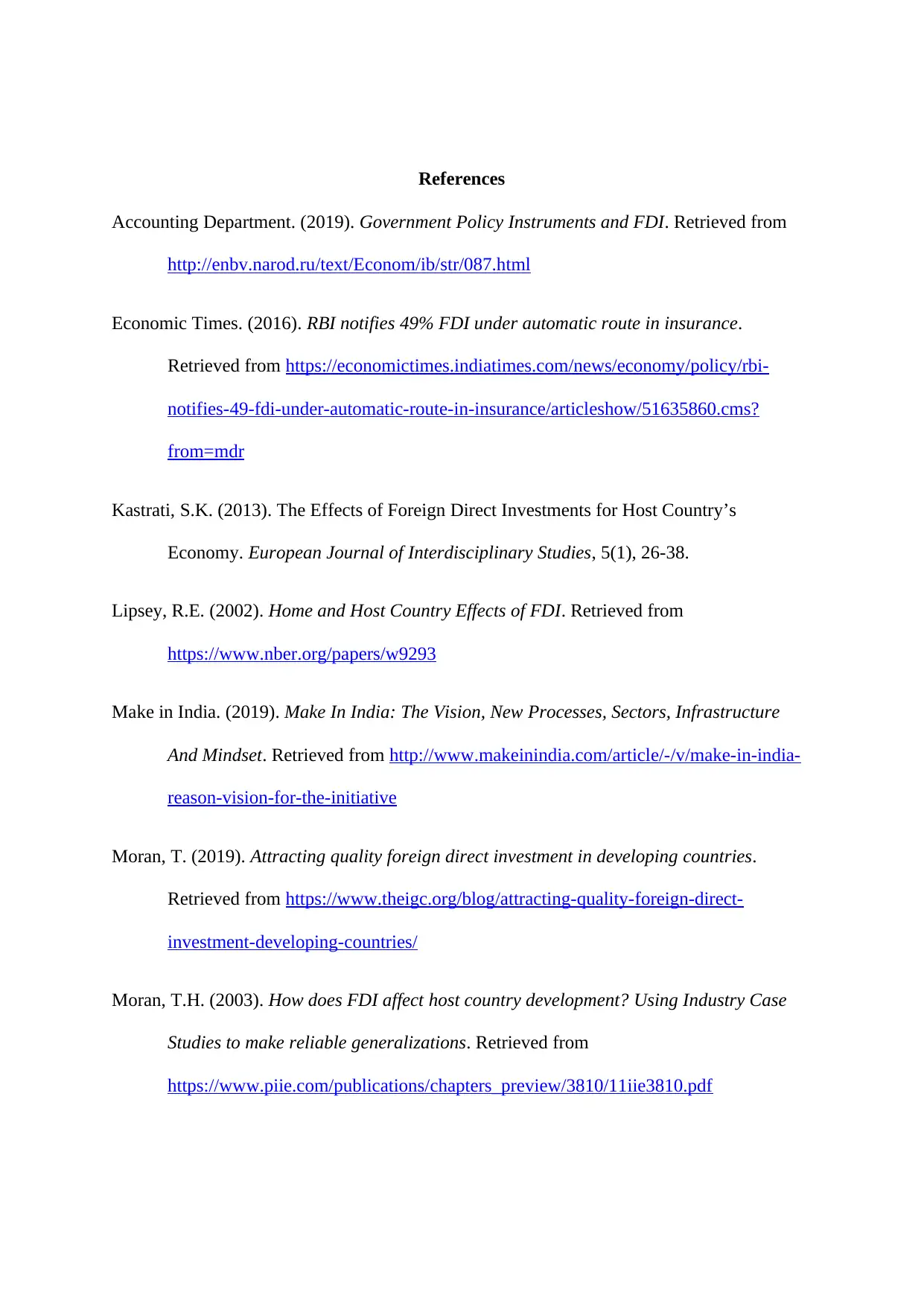
References
Accounting Department. (2019). Government Policy Instruments and FDI. Retrieved from
http://enbv.narod.ru/text/Econom/ib/str/087.html
Economic Times. (2016). RBI notifies 49% FDI under automatic route in insurance.
Retrieved from https://economictimes.indiatimes.com/news/economy/policy/rbi-
notifies-49-fdi-under-automatic-route-in-insurance/articleshow/51635860.cms?
from=mdr
Kastrati, S.K. (2013). The Effects of Foreign Direct Investments for Host Country’s
Economy. European Journal of Interdisciplinary Studies, 5(1), 26-38.
Lipsey, R.E. (2002). Home and Host Country Effects of FDI. Retrieved from
https://www.nber.org/papers/w9293
Make in India. (2019). Make In India: The Vision, New Processes, Sectors, Infrastructure
And Mindset. Retrieved from http://www.makeinindia.com/article/-/v/make-in-india-
reason-vision-for-the-initiative
Moran, T. (2019). Attracting quality foreign direct investment in developing countries.
Retrieved from https://www.theigc.org/blog/attracting-quality-foreign-direct-
investment-developing-countries/
Moran, T.H. (2003). How does FDI affect host country development? Using Industry Case
Studies to make reliable generalizations. Retrieved from
https://www.piie.com/publications/chapters_preview/3810/11iie3810.pdf
Accounting Department. (2019). Government Policy Instruments and FDI. Retrieved from
http://enbv.narod.ru/text/Econom/ib/str/087.html
Economic Times. (2016). RBI notifies 49% FDI under automatic route in insurance.
Retrieved from https://economictimes.indiatimes.com/news/economy/policy/rbi-
notifies-49-fdi-under-automatic-route-in-insurance/articleshow/51635860.cms?
from=mdr
Kastrati, S.K. (2013). The Effects of Foreign Direct Investments for Host Country’s
Economy. European Journal of Interdisciplinary Studies, 5(1), 26-38.
Lipsey, R.E. (2002). Home and Host Country Effects of FDI. Retrieved from
https://www.nber.org/papers/w9293
Make in India. (2019). Make In India: The Vision, New Processes, Sectors, Infrastructure
And Mindset. Retrieved from http://www.makeinindia.com/article/-/v/make-in-india-
reason-vision-for-the-initiative
Moran, T. (2019). Attracting quality foreign direct investment in developing countries.
Retrieved from https://www.theigc.org/blog/attracting-quality-foreign-direct-
investment-developing-countries/
Moran, T.H. (2003). How does FDI affect host country development? Using Industry Case
Studies to make reliable generalizations. Retrieved from
https://www.piie.com/publications/chapters_preview/3810/11iie3810.pdf
⊘ This is a preview!⊘
Do you want full access?
Subscribe today to unlock all pages.

Trusted by 1+ million students worldwide

-
1 out of 7
Related Documents
Your All-in-One AI-Powered Toolkit for Academic Success.
+13062052269
info@desklib.com
Available 24*7 on WhatsApp / Email
![[object Object]](/_next/static/media/star-bottom.7253800d.svg)
Unlock your academic potential
Copyright © 2020–2025 A2Z Services. All Rights Reserved. Developed and managed by ZUCOL.




